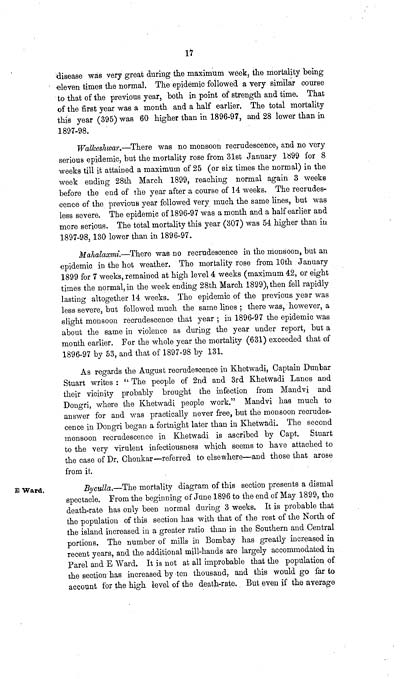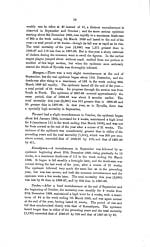Medicine - Disease > Report of the Municipal Commissioner on the plague in Bombay for the year ending 31st May... > Volume 1
(29) Page 17
Download files
Individual page:
Thumbnail gallery: Grid view | List view

17
disease was very great during the maximum week, the mortality being
eleven times the normal. The epidemic followed a very similar course
to that of the previous year, both in point of strength and time. That
of the first year was a month and a half earlier. The total mortality
this year (395) was 60 higher than in 1896-97, and 28 lower than in
1897-98.
Walkeshwar.-There was no monsoon recrudescence, and no very
serious epidemic, but the mortality rose from 31st January 1899 for 8
weeks till it attained a maximum of 25 (or six times the normal) in the
week ending 28th March 1899, reaching normal again 3 weeks
before the end of the year after a course of 14 weeks. The recrudes-
cence of the previous year followed very much the same lines, but was
less severe. The epidemic of 1896-97 was a month and a half earlier and
more serious. The total mortality this year (307) was 54 higher than in
1897-98, 130 lower than in 1896-97.
Mahalaxmi.-There was no recrudescence in the monsoon, but an
epidemic in the hot weather. The mortality rose from 10th January
1899 for 7 weeks, remained at high level 4 weeks (maximum 42, or eight
times the normal, in the week ending 28th March 1899), then fell rapidly
lasting altogether 14 weeks. The epidemic of the previous year was
less severe, but followed much the same lines ; there was, however, a
slight monsoon recrudescence that year; in 1896-97 the epidemic was
about the same in violence as during the year under report, but a
month earlier. For the whole year the mortality (631) exceeded that of
1896-97 by 53, and that of 1897-98 by 131.
As regards the August recrudescence in Khetwadi, Captain Dunbar
Stuart writes: " The people of 2nd and 3rd Khetwadi Lanes and
their vicinity probably brought the infection from Mandvi and
Dongri, where the Khetwadi people work." Mandvi has much to
answer for and was practically never free, but the monsoon recrudes-
cence in Dongri began a fortnight later than in Khetwadi. The second
monsoon recrudescence in Khetwadi is ascribed by Capt. Stuart
to the very virulent infectiousness which seems to have attached to
the case of Dr. Chonkar-referred to elsewhere-and those that arose
from it.
E Ward,
Byculla.-The mortality diagram of this section presents a dismal
spectacle. From the beginning of June 1896 to the end of May 1899, the
death-rate has only been normal during 3 weeks. It is probable that
the population of this section has with that of the rest of the North of
the island increased in a greater ratio than in the Southern and Central
portions. The number of mills in Bombay has greatly increased in
recent years, and the additional mill-hands are largely accommodated in
Parel and E Ward. It is not at all improbable that the population of
the section has increased by ten thousand, and this would go far to
account for the high level of the death-rate. But even if the average
disease was very great during the maximum week, the mortality being
eleven times the normal. The epidemic followed a very similar course
to that of the previous year, both in point of strength and time. That
of the first year was a month and a half earlier. The total mortality
this year (395) was 60 higher than in 1896-97, and 28 lower than in
1897-98.
Walkeshwar.-There was no monsoon recrudescence, and no very
serious epidemic, but the mortality rose from 31st January 1899 for 8
weeks till it attained a maximum of 25 (or six times the normal) in the
week ending 28th March 1899, reaching normal again 3 weeks
before the end of the year after a course of 14 weeks. The recrudes-
cence of the previous year followed very much the same lines, but was
less severe. The epidemic of 1896-97 was a month and a half earlier and
more serious. The total mortality this year (307) was 54 higher than in
1897-98, 130 lower than in 1896-97.
Mahalaxmi.-There was no recrudescence in the monsoon, but an
epidemic in the hot weather. The mortality rose from 10th January
1899 for 7 weeks, remained at high level 4 weeks (maximum 42, or eight
times the normal, in the week ending 28th March 1899), then fell rapidly
lasting altogether 14 weeks. The epidemic of the previous year was
less severe, but followed much the same lines ; there was, however, a
slight monsoon recrudescence that year; in 1896-97 the epidemic was
about the same in violence as during the year under report, but a
month earlier. For the whole year the mortality (631) exceeded that of
1896-97 by 53, and that of 1897-98 by 131.
As regards the August recrudescence in Khetwadi, Captain Dunbar
Stuart writes: " The people of 2nd and 3rd Khetwadi Lanes and
their vicinity probably brought the infection from Mandvi and
Dongri, where the Khetwadi people work." Mandvi has much to
answer for and was practically never free, but the monsoon recrudes-
cence in Dongri began a fortnight later than in Khetwadi. The second
monsoon recrudescence in Khetwadi is ascribed by Capt. Stuart
to the very virulent infectiousness which seems to have attached to
the case of Dr. Chonkar-referred to elsewhere-and those that arose
from it.
E Ward,
Byculla.-The mortality diagram of this section presents a dismal
spectacle. From the beginning of June 1896 to the end of May 1899, the
death-rate has only been normal during 3 weeks. It is probable that
the population of this section has with that of the rest of the North of
the island increased in a greater ratio than in the Southern and Central
portions. The number of mills in Bombay has greatly increased in
recent years, and the additional mill-hands are largely accommodated in
Parel and E Ward. It is not at all improbable that the population of
the section has increased by ten thousand, and this would go far to
account for the high level of the death-rate. But even if the average
Set display mode to: Large image | Zoom image | Transcription
Images and transcriptions on this page, including medium image downloads, may be used under the Creative Commons Attribution 4.0 International Licence unless otherwise stated. ![]()
| India Papers > Medicine - Disease > Report of the Municipal Commissioner on the plague in Bombay for the year ending 31st May... > Volume 1 > (29) Page 17 |
|---|
| Permanent URL | https://digital.nls.uk/74575148 |
|---|




